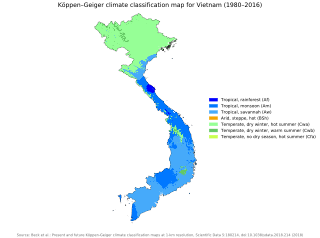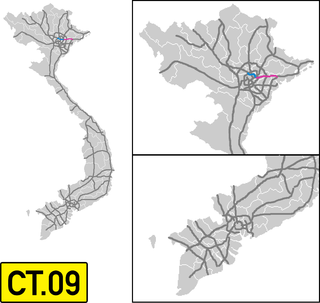| |||||
| Decades: | |||||
|---|---|---|---|---|---|
| See also: | |||||
The following lists events that happened during 2014 in Vietnam .
| |||||
| Decades: | |||||
|---|---|---|---|---|---|
| See also: | |||||
The following lists events that happened during 2014 in Vietnam .
Articles related to Vietnam and Vietnamese culture include:

Fansipan is a mountain in Vietnam. The height of the mountain was 3,143 metres (10,312 ft) in 1909, but now the height of the mountain is 3,147.3 metres (10,326 ft). It is the highest mountain in the Indochinese Peninsula, hence its nickname "the Roof of Indochina". It is located in the Lào Cai Province of the Northwest region of Vietnam, 9 km (5.6 mi) southwest of Sa Pa in the Hoang Lien Son mountain range. Administratively, it is shared between Tam Đường district, Lai Châu and Sa Pa town, Lào Cai.
Hải Dương is a city in Vietnam. It is the capital of Hải Dương, an industrialized province in the Hanoi Capital Region and the Red River Delta in Northern Vietnam. The city is at the midpoint between the capital Hanoi and major port Haiphong, and is part of the Northern Key Economic Zone. In 2019, Hai Duong city had a population of 507,469.

Lào Cai is a city in the Northwest region of Vietnam. It is the capital of Lào Cai Province. The city borders Bảo Thắng District, Bát Xát District, Sa Pa and the city of Hekou Yao Autonomous County, in Yunnan province of southwest China. It lies at the junction of the Red River and the Nanxi River (Yunnan) approximately 160 miles (260 km) northwest of Hanoi.

Lệ Thủy is a district of Quảng Bình province in the North Central Coast of Vietnam. The district borders Quảng Ninh district on the north, Vĩnh Linh district on the south, Laos on the west. Lệ Thủy central is 40 km south of the provincial capital Đồng Hới. The district government seat is Kiến Giang Township. The district area is 1420.52 km2, population: 140,804 (1998). Lệ Thủy district is home to Võ Nguyên Giáp and the family of Ngô Đình Diệm. Economy bases on agriculture, mainly rice culture. Mỹ Trạch massacre by French army happened here on 29 November 1947.
Phan Khôi was an intellectual leader who inspired a North Vietnamese variety of the Chinese Hundred Flowers Campaign, in which scholars were permitted to criticize the Communist regime, but for which he himself was ultimately persecuted by the Communist Party of Vietnam.
Việt Bắc is a region of Vietnam north of Hanoi that served as the Việt Minh's base of support during the First Indochina War (1946–1954).

Đông Triều is a district-level town of Quảng Ninh Province in the north-eastern region of Vietnam. As of 2015 the district had a population of 173,141. The district covers an area of 397.2155 km². The town capital lies at Đông Triều ward.

Hoàng Kế Viêm (1820–1909) was a Vietnamese General and a Dong'ge Grand Secretariat during the Nguyễn dynasty. He played a significant role in suppressing borderlands banditry and resisting French invasion during the second half of the 19th century.

Vietnam has a monsoon-influenced climate typical of that of mainland Southeast Asia. The diverse topography, long latitude, and influences from the South China Sea lead to climatic conditions varying significantly between regions. Northern Vietnam has a humid subtropical climate with the Köppen climate classification and has times to be influenced by cold waves from the Northeast, northern part of Central Vietnam also has times to be influenced by cold waves, southern part of Central Vietnam and Southern Vietnam are completely tropical and hot around year.
The 2nd Military Region of the Vietnam People's Army, is directly under the Ministry of Defence of Vietnam, tasked to organise, build, manage and commander armed forces defending the North West of Vietnam. The north-West region of Vietnam, borders with the Yunnan of China. In 1979, Chinese army with 3 infantry corps, 10 infantry divisions, launched a huge invasion in this military zone, and occupied Lào Cai Province and Phong Thổ.
The following is a list of political organizations and armed forces in Vietnam, since 1912:

Hoàng Diệu, born Hoàng Kim Tích (黃金錫), courtesy name Quang Viễn, was a Nguyễn dynasty Governor-general of Hà - Ninh, who suicided after failure in protecting Hà Nội citadel.

The China–Vietnam border is the international boundary between China and Vietnam, consisting of a 1,297 km (806 mi) terrestrial border stretching from the tripoint with Laos in the west to the Gulf of Tonkin coast in the east, and a maritime border in the Gulf of Tonkin and South China Sea.

The Lê–Mạc War was a 59 year-long civil war waged between two Vietnamese dynasties, the Mạc and Revival Lê, during the Southern and Northern Dynasties period of Vietnamese history.

Ninh Binh–Hai PhongºQuang Ninh Expressway is a partially completed expressway in Vietnam, running for 160 km connecting Ninh Binh to Quang Ninh. The route connects the northern coastal provinces of Vietnam with the North-South expressway.

The Nùng Autonomous Territory, also known as the Hải Ninh Autonomous Territory, the Nùng Hải Ninh Autonomous Territory, and the Nùng country, abbreviated as TAN, was an autonomous territory for the Chinese Nùng within the French Union created during the First Indochina War by the French colonial government in Indochina. During this period the French hoped to weaken the position of the Việt Minh by granting more autonomy to ethnic minorities in Vietnam in the hopes of getting more support from them in their fight against the predominantly Kinh Việt Minh, which took control of large parts of Vietnam following the August Revolution and the power vacuum that occurred following the surrender of Japan at the end of World War II.

The Battle of Cao Ba Lanh was part of the Battle of Móng Cái, fought during the Sino-Vietnamese War between February and March 1979 near the city of Móng Cái and other districts of Quảng Ninh Province that bordered the People's Republic of China. The battle broke out as Chinese People's Liberation Army (PLA) units launched diversionary attacks in support of the Chinese invasion in the major fronts of Lạng Sơn, Cao Bằng and Lào Cai. A Chinese regiment clashed with a Vietnamese platoon, taking heavy casualties to seize the strategic peak which was later recaptured by reinforcements.